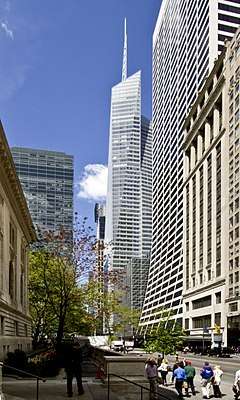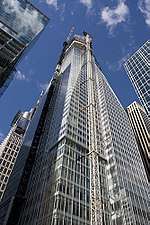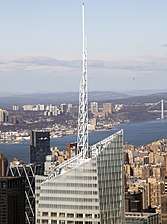Bank of America Tower (Manhattan)
The Bank of America Tower is a 1,200 ft (365.8 m) skyscraper in the Midtown area of Manhattan in New York City. It is located at One Bryant Park, on Sixth Avenue between 42nd and 43rd Streets diagonally opposite Bryant Park.
| Bank of America Tower | |
|---|---|
 Seen from the New York Public Library Main Branch, one block east | |
%26groups%3D_5c3fb3da8ff7183eb05f0e3bd0e9e00797120e0d.svg)
| |
| Alternative names | One Bryant Park |
| General information | |
| Type | Commercial offices |
| Location | Avenue of the Americas & 42nd Street Manhattan, New York 10036 |
| Coordinates | 40.755278°N 73.984167°W |
| Construction started | August 2, 2004 |
| Completed | 2009 |
| Cost | US$1 billion |
| Height | |
| Architectural | 365.8 m (1,200 ft)[1] |
| Roof | 287.9 m (945 ft) |
| Top floor | 234.5 m (769 ft)[1] |
| Technical details | |
| Floor count | 55[1] (+3 basement floors) (7 mechanical) |
| Floor area | 2,099,985 sq ft (195,095.0 m2) |
| Lifts/elevators | 52[1] |
| Design and construction | |
| Architect | COOKFOX Architects[1] Adamson Associates Architects |
| Developer | Durst Organization[1] |
| Structural engineer | Severud Associates |
| Main contractor | Tishman Construction Corporation[1] |
| References | |
| [1][2][3][4][5] | |
The US$1 billion project was designed by COOKFOX Architects. Work on the Bank of America Tower started in 2004[6] and it was completed in 2009.[7] The Bank of America Tower was appraised in July 2019 at over $3.5 billion, ranking it among the most valuable office buildings in the city.[8]
The Bank of America Tower is advertised to be one of the most efficient and ecologically friendly buildings in the world. It is the fifth tallest building in New York City, after One World Trade Center, 432 Park Avenue, 30 Hudson Yards, and the Empire State Building, and the seventh tallest building in the United States.
Details


The building is 55 stories high and contains 2.1 million square feet (195,096 m2) of office space. The tower's architectural spire is 255.5 ft (77.9 m) tall and was placed on December 15, 2007.
The tower includes three escalators and a total of 52 elevators: 50 to serve the offices and two leading to the New York City Subway's mezzanine below ground, for the 42nd Street–Bryant Park/Fifth Avenue station.[9] As part of the building's construction, a passageway was also built under the north side of 42nd Street connecting with the Times Square–42nd Street/Port Authority Bus Terminal station. The passageway has never been used, but as part of the reconstruction of 42nd Street Shuttle from 2019 to 2022, the passageway would be opened and a new entrance would be built on the north side of 42nd Street between Broadway and Sixth Avenue.[10][11]
Several buildings were demolished to make way for the tower. Among them was the Hotel Diplomat, a 13-story structure which had occupied the site at 108 West 43rd Street since 1911,[12] and Henry Miller's Theatre, which was rebuilt and reopened at its previous location. The building's tenants include Bank of America as the anchor tenant and Marathon Asset Management, and the tower's platinum LEED rating and modern column-free office space has enticed tenants from all over the city. The Bank of America Tower is considered a worldwide model for green architecture in skyscrapers.[13]
The building's Urban Garden Room at 43rd Street and Sixth Avenue is open to the public as part of the city's privately owned public space (POPS) program.
Environmental features

.jpg)
The design of the building makes it environmentally friendly, using technologies such as floor-to-ceiling insulated glazing to contain heat and maximize natural light, and an automatic daylight dimming system. The tower also features a greywater system, which captures rainwater for reuse. Bank of America states that the building is made largely of recycled and recyclable materials.[6] Air entering the building is filtered, as is common, but the air exhausted is cleaned as well.[14] Bank of America Tower is the first skyscraper designed to attain a Platinum LEED Certification.[6]
The Bank of America Tower is constructed using a concrete manufactured with slag, a byproduct of blast furnaces. The mixture used in the tower concrete is 55% cement and 45% slag. The use of slag cement reduces damage to the environment by decreasing the amount of cement needed for the building, which in turn lowers the amount of carbon dioxide greenhouse gas produced through the normal cement manufacturing process. Each ton of regular cement produced creates about one ton of carbon dioxide in the atmosphere.[15]
Temperature control and the production of some of its energy are accomplished in an environmentally friendly manner for the tower. Insulated glazing reduces thermal loss, lowering energy consumption and increasing transparency. Carbon dioxide sensors signal increased fresh air ventilation when elevated levels of carbon dioxide are detected in the building. Conditioned air for the occupants is provided by multiple air column units located in the tenant space that deliver 50 °F air into a raised access floor plenum. This underfloor air system provides users with the ability to control their own space temperature as well as improving the ventilation effectiveness. When building churn occurs, workstation moves can be performed more easily with lower cost and less product waste. The cooling system produces and stores ice during off-peak hours, and allows the ice to melt to help cool the building during peak load, similar to the ice batteries in the 1995 Hotel New Otani Tokyo in Japan.[16] Ice batteries have been used since absorption chillers first made ice commercially available 150 years ago, before the invention of the electric light bulb.[17]
Water conservation features in the tower include waterless urinals, which are estimated to save 8 million US gal (30,000,000 l) of water per year and reduce CO2 emissions by 144,000 lb (65,000 kg) per year (as calculated with the Pacific Institute water-to-air model).[18] The tower has a 4.6-megawatt cogeneration plant, which provides part of the base-load energy requirements.
Time magazine reported in August 2013 that the Bank of America Tower used twice as much energy overall as the Empire State Building, due to the large energy usage in the Bank of America Tower and the comparatively small occupancy rate of the Empire State Building.[19]
In summer 2013, the Durst Organization employed Brooklyn Grange Rooftop Farm to install and maintain two honeybee hives on the building.[20]
Height

With the architectural spire[21] included, the structural height of the Bank of America Tower is 1,200 ft (370 m), making it the fifth tallest building in New York City (after One World Trade Center, 432 Park Avenue, 30 Hudson Yards, and the Empire State Building). A formal ruling by the Council on Tall Buildings and Urban Habitat confirmed this.[22]
| Building Name |
Architectural Height |
Roof Height |
|---|---|---|
| One World Trade Center | 1,776 ft (541 m) | 1,368 ft (417 m) |
| 432 Park Avenue | 1,396 ft (426 m) | 1,396 ft (426 m) |
| Empire State Building | 1,472 ft (449 m) | 1,250 ft (380 m) |
| Bank of America Tower | 1,200 ft (370 m) | 953.5 ft (290.6 m) |
| Chrysler Building | 1,046 ft (319 m) | 925 ft (282 m) |
| New York Times Building | 1,046 ft (319 m) | 748 ft (228 m) |
Recognition


In June 2008, the New York Academy of Sciences launched a podcast that highlights these green features.[23]
In October 2009, the building was featured on episode 100 of the National Geographic Channel television series MegaStructures.[24]
In June 2010, the Bank of America Tower was the recipient of the 2010 Best Tall Building Americas award by the Council on Tall Buildings and Urban Habitat.[25]
Construction incidents
Materials fell from the building on three occasions:
- October 17, 2007: A construction container fell from a crane around 1 p.m., causing damage to the tower and injuring eight people on the sidewalk.[26] The container broke windows on several floors of the building, spraying debris that rained down on the streets below. Eight people suffered cuts and bruises. The Buildings Department temporarily stopped construction at the site.
- August 12, 2008: A 1,500-pound (680 kg) glass panel fell onto a sidewalk. Two people suffered minor injuries.[27]
- September 17, 2008: A debris container fell, shattered a panel of glass facade, and caused several pieces of glass to fall from the 50th floor to the sidewalk and street (West 42nd and Avenue of the Americas) at around 3:00 pm (EDT). No one was injured.[28]
See also
- Buildings and architecture of New York City
- List of tallest buildings in New York City
- Tallest buildings in the United States
References
- "Bank of America Tower - The Skyscraper Center". Council on Tall Buildings and Urban Habitat.
- Bank of America Tower at Emporis
- Bank of America Tower at Glass Steel and Stone (archived)
- "Bank of America Tower". SkyscraperPage.
- Bank of America Tower at Structurae
- "Bank of America and The Durst Organization Break Ground On the Bank of America Tower at One Bryant Park in New York City" (Press release). Bank of America Corporation. August 2, 2004. Archived from the original on October 23, 2007. Retrieved October 19, 2007.
- C.J. Hughes (November 5, 2008). "New Skyscraper Stars in National Geographic Show". Architectural Record. archrecord.construction.com. Archived from the original on June 12, 2011. Retrieved May 27, 2011.
- Grossman, Matt (July 31, 2019). "One Bryant Park Lands $1.6B CMBS Refi". Commercial Observer. Retrieved July 31, 2019.
- "One Bryant Park". Van Deusen & Associates. Retrieved February 27, 2014.
- "42nd Street Shuttle ADA, State of Good Repair, and Capacity Enhancement Project & Grand Central Station Elevator and Escalator Replacements" (PDF). cbsix.org. Metropolitan Transportation Authority. May 30, 2019. Retrieved June 14, 2019.
- "Memorandum of Agreement Between Federal Transit Administration New York State Historic Preservation Office New York City Transit Authority Regarding the Times Square Shuttle Station During Contract A-35302, The Reconfiguration of the Times Square Shuttle Station, SHPO Project #17PR00545" (PDF). mta.info. Metropolitan Transportation Authority. April 25, 2018. Archived from the original (PDF) on April 25, 2018. Retrieved April 27, 2018.
- Dunlap, David W. (November 7, 1993). "An Aging Midtown Hotel That Will Not Go Gently". The New York Times. NYTimes.com. Retrieved August 10, 2011.
- McDonnell, Tim (September 16, 2015). "There's been a boom in energy-efficient skyscraper construction". Grist.
- Cook, Richard A.; Hartley, Alice (June 6, 2005). ""What is Free?": How Sustainable Architecture Act and Interacts Differently" (PDF). United Nations. Archived (PDF) from the original on November 28, 2007. Retrieved October 19, 2007. Cite journal requires
|journal=(help) - "EF Technology". U.S. Concrete, Inc. Archived from the original on October 5, 2007. Retrieved November 8, 2007.
- "Ice-cooling System Reduces Environmental Burden". The New Otani News. New Otani Co., Ltd. June 28, 2000. Archived from the original on October 7, 2007. Retrieved November 8, 2007.
- Foley, Gearoid; DeVault, Robert; Sweetser, Richard. "The Future of Absorption Technology in America" (PDF). U.S. DOE Energy Efficiency and Renewable Energy (EERE). Archived from the original (PDF) on November 28, 2007. Retrieved November 8, 2007.
- Pacific Institute. "Water to Air Models". Archived from the original on December 11, 2008. Retrieved June 13, 2008.
- Walsh, Bryan (August 14, 2013). "The Surprisingly Large Energy Footprint of the Digital Economy [UPDATE]". TIME.com. Retrieved September 18, 2015.
- Satow, Julie (August 6, 2013). "Worker Bees on a Rooftop, Ignoring Urban Pleasures". The New York Times. The New York Times Company. Retrieved February 27, 2014.
- "Photo of Bank of America Tower: Elevations". Emporis. Cook + Fox Architects, LLP. September 4, 2005. Retrieved October 19, 2007.
- "100 tallest completed buildings in the world". Council on Tall Buildings and Urban Habitat. February 3, 2011. Retrieved May 1, 2012.
- "Green Buildings Solutions: What's Working? Post Occupancy Evaluation". New York Academy of Sciences. April 15, 2010. Retrieved February 27, 2014.
- See MegaStructures
- "CTBUH 9th Annual Awards, 2010". Council on Tall Buildings and Urban Habitat. Retrieved June 15, 2007.
- "Crane's Bucket Falls 53 Stories In Midtown". WNBC. October 17, 2007. Archived from the original on October 4, 2008. Retrieved October 19, 2007.
- Hauser, Christine (August 12, 2008). "At a Midtown Intersection, Another Sheet of Glass Falls". The New York Times. Retrieved August 26, 2008.
- "Glass Falls 50 Floors From Midtown Building". NY1. September 17, 2008. Retrieved February 27, 2014.
Further reading
- Dirk Stichweh: New York Skyscrapers. Prestel Publishing, Munich, 2009, ISBN 3-7913-4054-9
- The Bank of America - Megastructure at One Bryant Park Archived August 10, 2009, at the Wayback Machine
- National Geographic Channel - "Man-Made: Ultimate Skyscraper" (Television Episode)
- Curbed NY topic
- The Site Selection report on the tower
- Bank of America press release on the tower
External links
| Wikimedia Commons has media related to Bank of America Tower (Manhattan). |
- Bank of America Tower on Emporis
- Bank of America Tower on Skyscraper Center
- Bank of America Tower on the Durst Organization website
- Wirednewyork.com site photos
